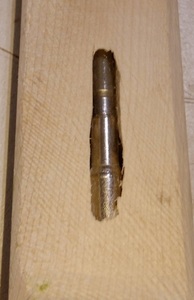Got 'over brave' trying to carve something that wasn't a baseball bat and I forgot that this truss rod was deeper than the last few I've bought ...
Bloody annoying as I'd done a really good job of fretboard, frets, and marker dots etc.
I know the neck is now firewood but does anyone have any tips to get he fretboard off without distroying it?
Guitar making is the art and science of turning expensive wood into sawdust.
@rockpile99 Oh no! I don’t know about this myself but it will be good to hear from @markbailey so we can all learn from it. Even if it is knackered, I would keep it for cutting inlay dots out of, even from the fretboard.
Make guitars, not war 🌍✌️🎸
Thanks everyone.
I'm sure I could effect a cosmetic repair ... I guess doing it in a way that doesn't self-destruct on the first turn of the truss rod will be the key.
I use the same template for my necks, so if I can get the fret board off intact that can be re-used.
Now I've finished sulking with myself I'll hold off on the viking funeral and get my thinking cap on. 🙂
Guitar making is the art and science of turning expensive wood into sawdust.
Route out a fake skunk stripe? Stop just shy of the heel.
Adding a fake skunk stripe would be the best disguise, but I'm not sure that routing more material out of the neck would be a good idea. Personally I would try to find an offcut that best matches the grain and fit it in. With it being so close the the nut, I don't think that you need to worry about the truss rod pushing it out. Having said all that, I'm no expert.
oh man! I am working on my first neck i am wondering if I removed too much material?!
Thanks to Mark’s expert instructions this is my current state of play:
I fortunately haven't blown through to the truss rod slot but I am wondering how thin is too thin when it comes to the wood between the bottom of the groove and the back of the neck? Your experienced opinions would be very much appreciated!
-D
Your experienced opinions would be very much appreciated
Hi Dave, I can only offer an inexperienced opinion. If you've been working to Mark's dimension I don't think you need to concerned about the thickness. Your neck carving is looking good. You've maybe taken the truss rod slot a bit too far into the headstock, hard to tell from the photo. I made a real mess of that part on my first build, but I filled it in, tidied it up and put a veneer over to hide the mess. It hasn't caused any structural problems.
@Dave, there is generally give or take 1/8 to 3/16 of an inch of meat underneath the truss rod after the the neck is carved. Bare that in mind on your next build. The weakest point is in between the nut and the first fret. I tend to make sure that the thinnest point of the neck carve is just right after the first fret and have a gradual thickness going back towards the volute and the nut leading into the headstock.
Lol yeah.... Definitely a little too far! The plan is to compensate with a nice cover... 🙂
I definitely worked to marks dimensions but the stew mac hot rod truss rods seem a bit tall! That plus the fillet has me a little nervous.
Thanks man!
-D
"I fortunately haven't blown through to the truss rod slot but I am wondering how thin is too thin when it comes to the wood between the bottom of the groove and the back of the neck? Your experienced opinions would be very much appreciated!"
Another inexperienced opinion; My last neck is around 19mm thick at the first fret with 6mm of that being fretboard. Plays lovely and no problems when adjusting truss rod. As my cock-up clearly demonstrates - it all depends on how deep your channel is ...
Guitar making is the art and science of turning expensive wood into sawdust.
I'll try and tune in to the Live tomorrow (missed the last few weeks because work has been so busy).
Here are a couple more pictures
Had this been my previous truss rod purchases which were 9mm high I still would have had at least 3mm of wood.
I guess the lessons learned (apart from don't take too wood you plonker) are to not to "buy truss rods because they're in stock and you have a child free weekend coming up" and to write down how deep the truss rod channel actually ended up and keep the information handy for when you carve.
Guitar making is the art and science of turning expensive wood into sawdust.
I know the neck is now firewood but does anyone have any tips to get he fretboard off without distroying it?
I did do that once - really just as an experiment to find out whether I could or not.
You're supposed to be able to do it by melting / loosening the glue. Apply an iron to the frets, and let the heat work through the fretboard and into the glue layer. As the glue loosens, try to work a blade (scraper) into the joint between fretboard and neck, and then gradually work your way up the fretboard, applying heat, loosening the glue and moving the scraper further up the neck.
You can also try removing some frets, drilling a (very) small hole in the fret slot and injecting steam, but that requires a bit more kit.
I took the fairly blunt approach of rigging up a jig to hold the neck vertically (along it's length) and then using the bandsaw to cut the fretboard off. That's going to leave a bit of gunk on the underside of the board which then needs cleaning off, and you have to be *very* careful not to cut into the fretboard - but it worked.
That said, it's a load of aggro, and you'll probably need to re-level the frets when you re-apply the saved fretboard to another neck, so might not be worth doing?
Online guitar making courses – guitarmaking.co.uk
Thanks TV1 🙂
The fretboard still has plenty of meat on it, so trying removal might be worth a shot. Hadn't leveled yet so no time lost there thankfully.
Will save it for a rainy/bored day mini project though I think...
Guitar making is the art and science of turning expensive wood into sawdust.
After removing the fretboard it’s bound to go all wonky so if you were to reuse it you’d have to re-level the board and then refret it, ugh...
Remove it if you like for the experience but maybe Mark’s suggestion as an ornament is best.
Be creative: it could make a cool door handle for your shop or cut off the headstock and use the tuner holes as tool holders.
Have fun!
Practice on scrap...
For what it’s worth I’ve removed the fretboard from an Encore strat copy I was donated. The truss rod adjuster was destroyed and there was some damage around the adjuster access along with a small chip. So I replaced the truss rod in it and remade the surround for the adjuster and put it back together.
I used the technique of heating with an iron and sliding a paint scraper down which works but is quite brutal to say the least. I needed to level and dress the frets after but as a first attempt at this repair it was quite successful.
The fretboard came off quite cleanly though and didn’t need a lots of elbow grease to clean up.
…on an elaborate journey to turn trees into music.













